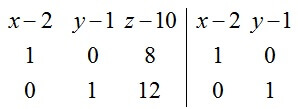A derivada parcial é basicamente a derivada de uma função com diversas variáveis, em que apenas uma das variáveis é mantida como variável, e as outras variáveis são mantidas como constantes.
Sendo em uma função z = f (x,y), que é composta por duas variáveis, podemos obter a derivada parcial de z em relação a x através de:
$\frac{\partial z}{\partial x}=\underset{h\to 0}{\mathop{\lim }}\,=\frac{f\left( x+h,y \right)-f\left( x,y \right)}{h}$
Sendo, analogamente, a derivada parcial de z em relação à y:
$\frac{\partial z}{\partial y}=\underset{h\to 0}{\mathop{\lim }}\,=\frac{f\left( x,h+y \right)-f\left( x,y \right)}{h}$
Exemplo de derivada parcial aplicando limite
1) Calcule $~\frac{\partial z}{\partial x}~~e~~\frac{\partial z}{\partial y}~~$ para $~z={{x}^{2}}y+3x{{y}^{2}}+5x+7y+1$. (Observação: Caso você não se lembre de limite, sugiro que você veja nossa postagem sobre a determinação do limite de uma função).
Derivando em x:
$\frac{\partial z}{\partial x}=\underset{h\to 0}{\mathop{\lim }}\,=\frac{f\left( x+h,y \right)-f\left( x,y \right)}{h}\Rightarrow $
Calculando f (x + h, y):
$f\left( x+h,y \right)={{x}^{2}}y+3x{{y}^{2}}+5x+7y+1\Rightarrow $
$\Rightarrow f\left( x+h,y \right)={{\left( x+h \right)}^{2}}y+3\left( x+h \right){{y}^{2}}+5\left( x+h \right)+7y+1\Rightarrow $
$\Rightarrow f\left( x+h,y \right)=\left( {{x}^{2}}+2xh+{{h}^{2}} \right)y+3x{{y}^{2}}+3h{{y}^{2}}+5x+5h+7y+1\Rightarrow $
$\Rightarrow f\left( x+h,y \right)={{x}^{2}}y+2xhy+{{h}^{2}}y+3x{{y}^{2}}+3h{{y}^{2}}+5x+5h+7y+1$
Como f(x, y) é igual a z:
$f\left( x,y \right)={{x}^{2}}y+3x{{y}^{2}}+5x+7y+1$
Logo, calculando f (x + h, y) - f(x, y):
$f\left( x+h,y \right)-f\left( x,y \right)=\left( {{x}^{2}}y+2xhy+{{h}^{2}}y+3x{{y}^{2}}+3h{{y}^{2}}+5x+5h+7y+1 \right)-\left( {{x}^{2}}y+3x{{y}^{2}}+5x+7y+1 \right)\Rightarrow $
$\Rightarrow f\left( x+h,y \right)-f\left( x,y \right)=\left( 2xhy+{{h}^{2}}y+3h{{y}^{2}}+5h \right)$
Montando o limite:
$\frac{\partial z}{\partial x}=\underset{h\to 0}{\mathop{\lim }}\,=\frac{f\left( x+h,y \right)-f\left( x,y \right)}{h}\Rightarrow $
$\Rightarrow \frac{\partial z}{\partial x}=\underset{h\to 0}{\mathop{\lim }}\,=\frac{2xhy+{{h}^{2}}y+3h{{y}^{2}}+5h}{h}\Rightarrow $
$\Rightarrow \frac{\partial z}{\partial x}=\underset{h\to 0}{\mathop{\lim }}\,=2xy+hy+3{{y}^{2}}+5\Rightarrow $
$\Rightarrow \frac{\partial z}{\partial x}=\underset{h\to 0}{\mathop{\lim }}\,=2xy+\left( 0 \right)y+3{{y}^{2}}+5=2xy+3{{y}^{2}}+5$
Agora, derivando em y:
$\frac{\partial z}{\partial y}=\underset{h\to 0}{\mathop{\lim }}\,=\frac{f\left( x,h+y \right)-f\left( x,y \right)}{h}\Rightarrow $
Calculando f (x, h +y):
$f\left( x,h+y \right)={{x}^{2}}y+3x{{y}^{2}}+5x+7y+1\Rightarrow $
$f\left( x,h+y \right)={{x}^{2}}\left( h+y \right)+3x{{\left( h+y \right)}^{2}}+5x+7\left( h+y \right)+1\Rightarrow $
$f\left( x,h+y \right)={{x}^{2}}\left( h+y \right)+3x\left( {{h}^{2}}+2hy+{{y}^{2}} \right)+5x+7\left( h+y \right)+1\Rightarrow $
$f\left( x,h+y \right)={{x}^{2}}h+{{x}^{2}}y+3x{{h}^{2}}+6xhy+3x{{y}^{2}}+5x+7h+7y+1$
Como f(x, y) é igual a z:
$f\left( x,y \right)={{x}^{2}}y+3x{{y}^{2}}+5x+7y+1$
Logo, calculando f (x + h, y) - f(x, y):
$f\left( x,h+y \right)-f\left( x,y \right)=\left( {{x}^{2}}h+{{x}^{2}}y+3x{{h}^{2}}+6xhy+3x{{y}^{2}}+5x+7h+7y+1 \right)-\left( {{x}^{2}}y+3x{{y}^{2}}+5x+7y+1 \right)\Rightarrow$
$\Rightarrow f\left( x,h+y \right)-f\left( x,y \right)=\left( {{x}^{2}}h+3x{{h}^{2}}+6xhy+7h \right)$
Montando o limite:
$\frac{\partial z}{\partial y}=\underset{h\to 0}{\mathop{\lim }}\,=\frac{f\left( x,h+y \right)-f\left( x,y \right)}{h}\Rightarrow $
$\Rightarrow \frac{\partial z}{\partial y}=\underset{h\to 0}{\mathop{\lim }}\,=\frac{{{x}^{2}}h+3x{{h}^{2}}+6xhy+7h}{h}\Rightarrow $
$\Rightarrow \frac{\partial z}{\partial y}=\underset{h\to 0}{\mathop{\lim }}\,={{x}^{2}}+3xh+6xy+7$ $\Rightarrow \frac{\partial z}{\partial y}=\underset{h\to 0}{\mathop{\lim }}\,={{x}^{2}}+3x\left( 0 \right)+6xy+7={{x}^{2}}+6xy+7$
Exemplos de derivada parcial aplicando regras de derivação
1) Derive as equações abaixo usando regras de derivação. (Observação: Caso você não se lembre das regras de derivação, sugiro que você veja nossa postagem sobre regras de derivação.)
Derivando em x:
$\frac{\partial z}{\partial x}=y~$
Derivando em y:
$\frac{\partial z}{\partial y}=x$
$b)z={{x}^{2}}+x{{y}^{2}}$
Derivando em x:
$\frac{\partial z}{\partial x}=2x+{{y}^{2}}$
Derivando em y:
$\frac{\partial z}{\partial x}=2xy$
$c)z={{\left( 3{{x}^{2}}{{y}^{5}}+7x{{y}^{3}}-9x+5y+1 \right)}^{3}}$
Derivando em x:
$\frac{\partial z}{\partial x}=3\left( 3{{x}^{2}}{{y}^{5}}+7x{{y}^{3}}-9x+5y+1 \right).\left( 6x{{y}^{5}}+7{{y}^{3}}-9 \right)$
Derivando em y:
$\frac{\partial z}{\partial y}=3\left( 3{{x}^{2}}{{y}^{5}}+7x{{y}^{3}}-9x+5y+1 \right).\left( 15{{x}^{2}}{{y}^{4}}+21x{{y}^{2}}+5 \right)$
$d)z=\left( {{x}^{2}}+{{y}^{2}} \right).sen\left( 2x+3y \right)$
Aplicando regra de derivação U´V+UV’:
$\frac{\partial z}{\partial y}=3\left( 3{{x}^{2}}{{y}^{5}}+7x{{y}^{3}}-9x+5y+1 \right).\left( 15{{x}^{2}}{{y}^{4}}+21x{{y}^{2}}+5 \right)$
$d)z=\left( {{x}^{2}}+{{y}^{2}} \right).sen\left( 2x+3y \right)$
Aplicando regra de derivação U´V+UV’:
Derivando em x:
$\frac{\partial z}{\partial x}=2x.sen\left( 2x+3y \right)+\left( {{x}^{2}}+{{y}^{2}} \right).\cos \left( 2x+3y \right).2$
$\frac{\partial z}{\partial x}=2x.sen\left( 2x+3y \right)+\left( {{x}^{2}}+{{y}^{2}} \right).\cos \left( 2x+3y \right).2$
Derivando em y:
$\frac{\partial z}{\partial y}=2y.sen\left( 2x+3y \right)+\left( {{x}^{2}}+{{y}^{2}} \right).\cos \left( 2x+3y \right).3$
Interpretação geométrica das derivadas parciais
Nas funções com duas variáveis, as derivadas parciais podem ser usadas para representar a taxa de variação de uma função f(x, y), podendo ser aplicada na determinação de um plano e das retas tangentes em um gráfico.
Exemplo de aplicação:
1) Seja z = f(x, y) = x²y + xy³ +3x +2y -4 e o ponto P = (2,1) de seu domínio, calcule:
a) a reta tangente ao gráfico de z em P paralelo ao plano xz;
b) a reta tangente ao gráfico de z em P paralelo ao plano yz;
c) o plano tangente ao gráfico de z em P.
Resolução
$\frac{\partial z}{\partial x}=2x+{{y}^{3}}+3~~e~~\frac{\partial z}{\partial y}={{x}^{3}}+3x{{y}^{2}}+2$
$P=\left( \overset{x}{\mathop{2}}\,,\overset{y}{\mathop{1}}\, \right)$
$\frac{\partial z}{\partial x}=2\left( 2 \right)+{{\left( 1 \right)}^{3}}+3~=8~~~e~~~\frac{\partial z}{\partial y}={{\left( 2 \right)}^{3}}+3\left( 2 \right){{\left( 1 \right)}^{2}}+2=12$
Substituindo x e y em z:
$Z\left( P \right)={{\left( 2 \right)}^{2}}.\left( 1 \right)+\left( 2 \right).{{\left( 1 \right)}^{3}}+\left( 3 \right).\left( 2 \right)+\left( 2 \right).\left( 1 \right)-4=10$
Logo,
$P=\left( \overset{x}{\mathop{2}}\,,\overset{y}{\mathop{1}}\,,\overset{z}{\mathop{10}}\, \right)$
Determinando os pontos das retas tangentes ao gráfico de z em P. (Item A e B)
$\frac{\partial z}{\partial x}=2x+{{y}^{3}}+3~~e~~\frac{\partial z}{\partial y}={{x}^{3}}+3x{{y}^{2}}+2$
$P=\left( \overset{x}{\mathop{2}}\,,\overset{y}{\mathop{1}}\, \right)$
$\frac{\partial z}{\partial x}=2\left( 2 \right)+{{\left( 1 \right)}^{3}}+3~=8~~~e~~~\frac{\partial z}{\partial y}={{\left( 2 \right)}^{3}}+3\left( 2 \right){{\left( 1 \right)}^{2}}+2=12$
Substituindo x e y em z:
$Z\left( P \right)={{\left( 2 \right)}^{2}}.\left( 1 \right)+\left( 2 \right).{{\left( 1 \right)}^{3}}+\left( 3 \right).\left( 2 \right)+\left( 2 \right).\left( 1 \right)-4=10$
Logo,
$P=\left( \overset{x}{\mathop{2}}\,,\overset{y}{\mathop{1}}\,,\overset{z}{\mathop{10}}\, \right)$
Determinando os pontos das retas tangentes ao gráfico de z em P. (Item A e B)
Andou uma unidade para x e z variou em 8,
Andou uma unidade para y e z variou em 12.
$x=P-m(PA)\Rightarrow x=\left( 2,1,10 \right)+m\left( A-P \right)\Rightarrow $
$x=\left( 2,1,10 \right)+m\left( \left( 3,1,18 \right)-\left( 2,1,10 \right) \right)\Rightarrow x=\left( 2,1,10 \right)+m\left( 1,0,8 \right)$
Obtendo a equação de reta do item B, que passa por (2,1,10) e (2,2,22):
$x=P-m(PB)\Rightarrow x=\left( 2,1,10 \right)+m\left( B-P \right)\Rightarrow $
$x=\left( 2,1,10 \right)+m\left( \left( 2,2,22 \right)-\left( 2,1,10 \right) \right)\Rightarrow x=\left( 2,1,10 \right)+m\left( 0,1,12 \right)$
Obtendo a equação do plano que passa por (2,1,10) , (3,1,18) e (2,2,22):
$\Rightarrow 8x+12y-z=18$
Diferenciabilidade de uma derivada parcial
Se as derivadas parciais fx e fy existirem perto de (x0, y0) e forem contínuas em (x0, y0), logo f é diferenciável em (a, b), sendo que essa diferenciabilidade pode ser dada por:
$\Delta z=\frac{\partial z}{\partial x}\left( P \right).\Delta x+\frac{\partial z}{\partial y}\left( P \right).\Delta y$
Exemplos de aplicação1) No ponto (x,y) de uma chapa plana, a temperatura é dada por :
$T\left( x,y \right)=20.{{e}^{\frac{{{x}^{2}}+4y}{50}}}$ com “x” e “y” em centímetros e “T” em °C.
a) Calcule a temperatura no ponto P = (3,4);
b) Calcule a taxa de variação de T em f na direção do eixo x;
c) Calcule a taxa de variação de T em P na direção do eixo y;
d) Use a diferenciabilidade para estimar T no ponto P(3.02,4.01).
Resolução:
$T\left( x,y \right)=20.{{e}^{\frac{{{x}^{2}}+4y}{50}}}$
$a){{T}_{\left( P \right)}}=20.{{e}^{\frac{{{3}^{2}}+4\left( 4 \right)}{50}}}=20.e{{~}^{\frac{1}{2}}}=32,97{}^\circ C$
$b)\frac{\partial T}{\partial x}=20.{{e}^{\frac{{{x}^{2}}+4y}{50}}}.\frac{1}{50}.2x\Rightarrow $
Sendo $T=20.{{e}^{\frac{{{x}^{2}}+4y}{50}}}$, logo, em x:
$\Rightarrow \frac{\partial T}{\partial x}=T.\frac{1}{50}.2x=0,04Tx$
$\Rightarrow \frac{\partial T}{\partial x}\left( P \right)=0,04Tx=0,04.\left( 3 \right).\left( 32,97 \right)=3,96{}^\circ C/cm$
$c)\frac{\partial T}{\partial y}=20.{{e}^{\frac{{{x}^{2}}+4y}{50}}}.\frac{1}{50}.4\Rightarrow $
Sendo $T=20.{{e}^{\frac{{{x}^{2}}+4y}{50}}}$, logo, em y:
$\Rightarrow \frac{\partial T}{\partial y}=T.\frac{1}{50}.4=0,08T$
$\Rightarrow \frac{\partial T}{\partial y}\left( P \right)=0,08T=0,08.\left( 32,97 \right)=2,64{}^\circ C/cm$
d)
$\Delta {{\text{T}}_{\text{1}}}=\frac{\partial T}{\partial x}\left( P \right).\Delta x=3,96.\left( {{x}_{1}}-{{x}_{0}} \right)=3,96.\left( 3,02-3,00 \right)=0,08$
$\Delta {{\text{T}}_{2}}=\frac{\partial T}{\partial y}\left( P \right).\Delta y=3,96.\left( {{y}_{1}}-{{y}_{0}} \right)=3,96.\left( 4,01-4,00 \right)=0,03$
$\Delta {{\text{T}}_{Total}}=0,08+0,03=0,11{}^\circ C$
$T\left( P \right)=32,97+0,11=33,08{}^\circ C$
2) O projeto de um tanque cilíndrico previa raio base de 2 m e altura de 4 m. Após a construção verificou-se um raio de 1,97 m e uma altura de 4,04 m. Use a diferenciabilidade para estimar a variação no volume do tanque.
$\Delta V1=\frac{\partial {{V}_{1}}}{\partial R}=\pi .H.2R=2\pi RH\Rightarrow$
$\Rightarrow \Delta V1=\frac{\partial {{V}_{1}}}{\partial R}=2\pi RH=2.\pi .2.4=16\pi {{m}^{3}}$
$\Delta V2=\frac{\partial {{V}_{2}}}{\partial H}=\pi .{{R}^{2}}\Rightarrow$
$\Rightarrow \Delta V2=\frac{\partial {{V}_{2}}}{\partial H}=\pi .{{\left( 2 \right)}^{2}}=4\pi {{m}^{3}}$
$\Delta V1=16\pi \left( -0,03 \right)=-0,48\pi$
$\Delta V2=4\pi \left( 0,04 \right)=0,16\pi$
$\Delta V=\Delta V1+\Delta V2\Rightarrow $
$\Delta V=-0,48\pi +0,16\pi =-0,32\pi \approx -1{{m}^{3}}$
Referências
- Notas de Cálculo Integral e Diferencial, Profº Sergio Louzada, Unisanta, Santos, São Paulo, 2011.
- Notas de Cálculo Integral e Diferencial, Pedro Coelho, Santos, São Paulo, 2011.;
- http://www.ime.unicamp.br/~valle/PastCourses/MA211_14/Aula4.pdf (acessado em 05/01/2016 as 18:16)
Sobre o autor
 Olá meu nome é Pedro Coelho, eu sou engenheiro químico, engenheiro de segurança do trabalho e Green Belt em Lean
Six Sigma. Além disso, também sou estudante de engenharia civil, e em parte de minhas horas vagas me dedico a escrever artigos aqui no ENGQUIMICASANTOSSP, para ajudar estudantes de Engenharia Química e de áreas correlatas. Se você está curtindo essa postagem, siga-nos através de nossas paginas nas redes sociais e compartilhe com seus amigos para eles curtirem também :)
Olá meu nome é Pedro Coelho, eu sou engenheiro químico, engenheiro de segurança do trabalho e Green Belt em Lean
Six Sigma. Além disso, também sou estudante de engenharia civil, e em parte de minhas horas vagas me dedico a escrever artigos aqui no ENGQUIMICASANTOSSP, para ajudar estudantes de Engenharia Química e de áreas correlatas. Se você está curtindo essa postagem, siga-nos através de nossas paginas nas redes sociais e compartilhe com seus amigos para eles curtirem também :)





0 Comentários de "Derivadas Parciais – Aplicando limite e regras de derivação"
Os comentários são sempre bem vindos, pois agregam valor ao artigo. Porém, existem algumas regras na Política de Comentários, que devem ser seguidas para o seu comentário não ser excluído:
- Os comentários devem estar relacionados ao assunto do artigo.
- Jamais faça um comentário com linguagem ofensiva ou de baixo calão, que deprecie o artigo exposto ou que ofenda o autor ou algum leitor do blog.
- Não coloque links de sites ou blogs no corpo do texto do comentário. Para isso, assine com seu Nome/URL ou OpenID.
-Não coloque seu email e nem seu telefone no corpo do texto do comentário. Use o nosso formulário de contato.
- Se encontrar algum pequeno erro na postagem, por favor, seja bem claro no comentário, pois a minha bola de cristal não é muito boa.
- Tem vezes que eu demoro pra responder, mas quase sempre eu respondo.
- Não seja tímido, se você tem alguma duvida ou sabe de algo mais sobre o assunto abordado no artigo, comente e compartilhe conosco :)